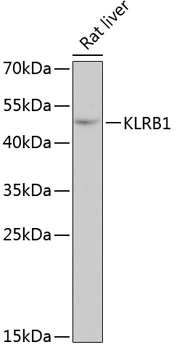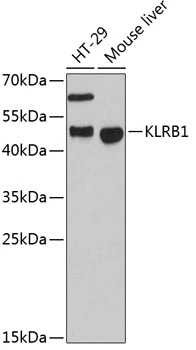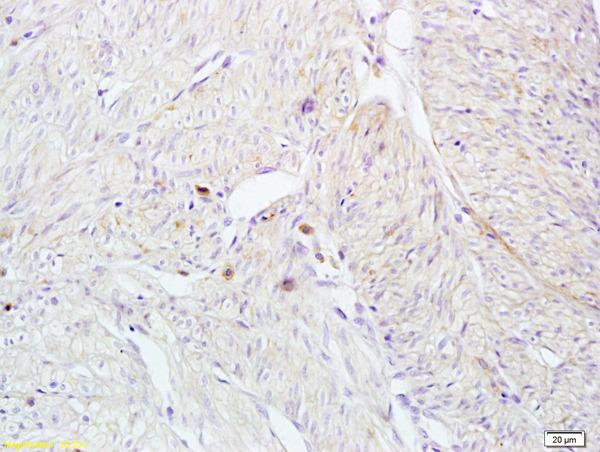
WB analysis of rat liver tissue lysate using GTX66487 CD161 antibody. Dilution : 1:3000 Loading : 25microg per lane
CD161 antibody
GTX66487
ApplicationsWestern Blot
Product group Antibodies
TargetKLRB1
Overview
- SupplierGeneTex
- Product NameCD161 antibody
- Delivery Days Customer9
- Application Supplier NoteWB: 1:500 - 1:2000. *Optimal dilutions/concentrations should be determined by the researcher.Not tested in other applications.
- ApplicationsWestern Blot
- CertificationResearch Use Only
- ClonalityPolyclonal
- ConjugateUnconjugated
- Gene ID3820
- Target nameKLRB1
- Target descriptionkiller cell lectin like receptor B1
- Target synonymsCD161, CLEC5B, NKR, NKR-P1, NKR-P1A, NKRP1A, hNKR-P1A, killer cell lectin-like receptor subfamily B member 1, C-type lectin domain family 5 member B, killer cell lectin-like receptor subfamily B, member 1, natural killer cell surface protein P1A
- HostRabbit
- IsotypeIgG
- Protein IDQ12918
- Protein NameKiller cell lectin-like receptor subfamily B member 1
- Scientific DescriptionNatural killer (NK) cells are lymphocytes that mediate cytotoxicity and secrete cytokines after immune stimulation. Several genes of the C-type lectin superfamily, including the rodent NKRP1 family of glycoproteins, are expressed by NK cells and may be involved in the regulation of NK cell function. The KLRB1 protein contains an extracellular domain with several motifs characteristic of C-type lectins, a transmembrane domain, and a cytoplasmic domain. The KLRB1 protein is classified as a type II membrane protein because it has an external C terminus. [provided by RefSeq, Jul 2008]
- Storage Instruction-20°C or -80°C,2°C to 8°C
- UNSPSC12352203






![FACS analysis of human peripheral blood lymphocytes using GTX01454-06 CD161 antibody [HP-3G10] (FITC). Solid lone : primary antibody Dashed line : isotype control antibody amount : 0.5 microg (5 microl)](https://www.genetex.com/upload/website/prouct_img/normal/GTX01454-06/GTX01454-06_20200428_FACS83_w_23053121_907.webp)
![FACS analysis of human peripheral blood lymphocytes using GTX01454-07 CD161 antibody [HP-3G10] (APC). Solid lone : primary antibody Dashed line : isotype control antibody amount : 0.25 microg (5 microl)](https://www.genetex.com/upload/website/prouct_img/normal/GTX01454-07/GTX01454-07_20200428_FACS25_w_23053121_702.webp)
![FACS analysis of human peripheral blood lymphocytes using GTX01454-08 CD161 antibody [HP-3G10] (PE). Solid lone : primary antibody Dashed line : isotype control antibody amount : 0.5 microg (5 microl)](https://www.genetex.com/upload/website/prouct_img/normal/GTX01454-08/GTX01454-08_20200428_FACS118_w_23053121_361.webp)
![FACS analysis of human peripheral blood lymphocytes using GTX01454-11 CD161 antibody [HP-3G10] (PerCP-Cy5.5). Solid lone : primary antibody Dashed line : isotype control antibody amount : 0.5 microg (5 microl)](https://www.genetex.com/upload/website/prouct_img/normal/GTX01454-11/GTX01454-11_20200428_FACS165_w_23053121_576.webp)